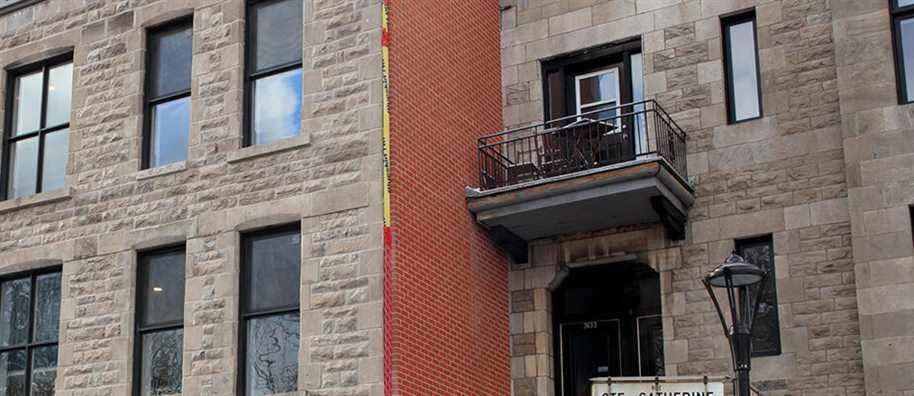After a history marked by criminal activities, drugs and prostitution, a former crackhouse from Hochelaga-Maisonneuve, in Montreal, changes vocation. On Friday, 3629 rue Sainte-Catherine will reopen its doors to welcome people from the street who do not fit into any other social housing project. A first in Quebec.
As a couple, without identity papers, drug addicts, sex workers, with animals or mental health problems: all these people will be welcome in the new rooming house inaugurated by the organization L’Anonyme in Montreal this Friday. A first in Quebec, according to the mayor of the borough, Pierre Lessard-Blais.
The building is located in a particularly hot area of the Mercier – Hochelaga-Maisonneuve district, where drug consumption and prostitution are part of everyday life.
This address – 3629 rue Sainte-Catherine – was frequented until 2018 by around 40 people, only a handful of whom were tenants. The building is known to have housed drugstores as well as criminal activities linked to prostitution and to have been the site of homicides and plagued by unsanitary conditions.

PHOTO OLIVIER JEAN, PRESS ARCHIVES
Until 2018, 3629 Sainte-Catherine Street was frequented by around 40 people, only a handful of whom were tenants.
Ravaged by a fire in 2018, the building was then bought by the community organization L’Anonyme with the support of the City of Montreal. After renovation work spread over several years, the organization is ready to welcome its first tenants.
The project of a district
The rooming house has 14 lodgings, two of which are doubles, spread over three floors. Each of them contains a bed, a small wooden table with two chairs, a counter with a sink, a microwave and a small refrigerator. Future tenants will also have common access to a kitchen, bathrooms, showers and toilets.
This scene has nothing to do with the images of the place before the fire. Photos viewed by Press show a shambles of stacked furniture, dirty toilets and cans of paint.

PHOTO PROVIDED BY THE ANONYMOUS
3629, rue Sainte-Catherine, before the building was destroyed by fire in 2018
The idea of acquiring the building to transform it into a community project dates back about four years. L’Anonyme – which distributes syringes and condoms throughout Montreal in its intervention bus – knew well the individuals who frequented 3629 rue Sainte-Catherine. “Many of these people were looking for accommodation or accommodation, but we weren’t able to find them. [diriger vers des organismes d’hébergement] », Explains Julien Montreuil, deputy director of L’Anonyme. “Either because they used to drink, or because they were in a relationship, because they had psychological or even physical health issues. ”

PHOTO PROVIDED BY THE ANONYMOUS
3629, rue Sainte-Catherine, before the building was destroyed by fire in 2018
In 2018, L’Anonyme thus became the bearer of a project that united the entire district. “Everyone got together to create something that didn’t exist, the job [de police] neighborhood, organizations, all elected officials, ”says Pierre Lessard-Blais, mayor of the borough.
The project received a grant of nearly $ 3.3 million from the City of Montreal as part of its 12,000 housing strategy as well as funding from the federal government and the CIUSSS du Center-Sud-de- the Island of Montreal.
Taming the neighborhood
Press spoke with two businesses located nearby in the neighborhood, who did not believe that the arrival of this new rooming house was problematic for them. “There are still crackhouses », Explained the owner of La Bonne Bouffe Créole. ” It is not finished. This address, maybe, but there are others, many more. ”
“I have no problem with that,” also said a neighbor who has lived nearby for 13 years. “We are in a neighborhood where there should be even more to fight homelessness and for those who would like to get off the streets. ”
According to Geneviève Groulx, who lives a street corner away, this home is necessary. “I absolutely agree that there are initiatives like that in the neighborhoods where people are,” she said.
Aware that cohabitation with the neighborhood can sometimes be difficult, L’Anonyme went door to door upstream to explain the project. “You have to see the work that has been done over the past three years to prepare the ground,” explains Julien Montreuil.
Help without forcing
In the last week, L’Anonyme conducted short interviews to choose the future residents of the project. The selection process is the opposite of what is done anywhere else. “The fewer housing options you have, the more you meet the criteria,” says Julien Montreuil. Some of the successful candidates are even people who previously frequented 3629 Sainte-Catherine Street.
The project has the particularity of offering housing without forcing people to receive assistance.

PHOTO ALAIN ROBERGE, THE PRESS
Julien Montreuil, deputy director of L’Anonyme
Often the accommodation [social] becomes conditional on steps taken to improve living conditions. But there is a part of the people who are not in there at all.
Julien Montreuil, deputy director of L’Anonyme
In this vein, no worker from L’Anonyme will be on site at all times. A coordinator will come to visit the building and offer support at the request of the residents. The other neighborhood organizations will also be involved in community life.
If the project works, it could pave the way for others like it in the province. “There are a lot of eyes on the 3629,” observes Pierre Lessard-Blais. There is a strong interest in all of Quebec for this type of housing. ”
40%
Proportion of the rooming house stock that disappeared in Montreal from 1977 to 1987, according to a 1987 homeless committee report
Number of single rooms in Montreal
In 2006: 2915
In 2017: 2400
Source: Report on the Safeguarding of Rooming Houses of the Assistance Network for Single and Homeless Persons of Montreal

